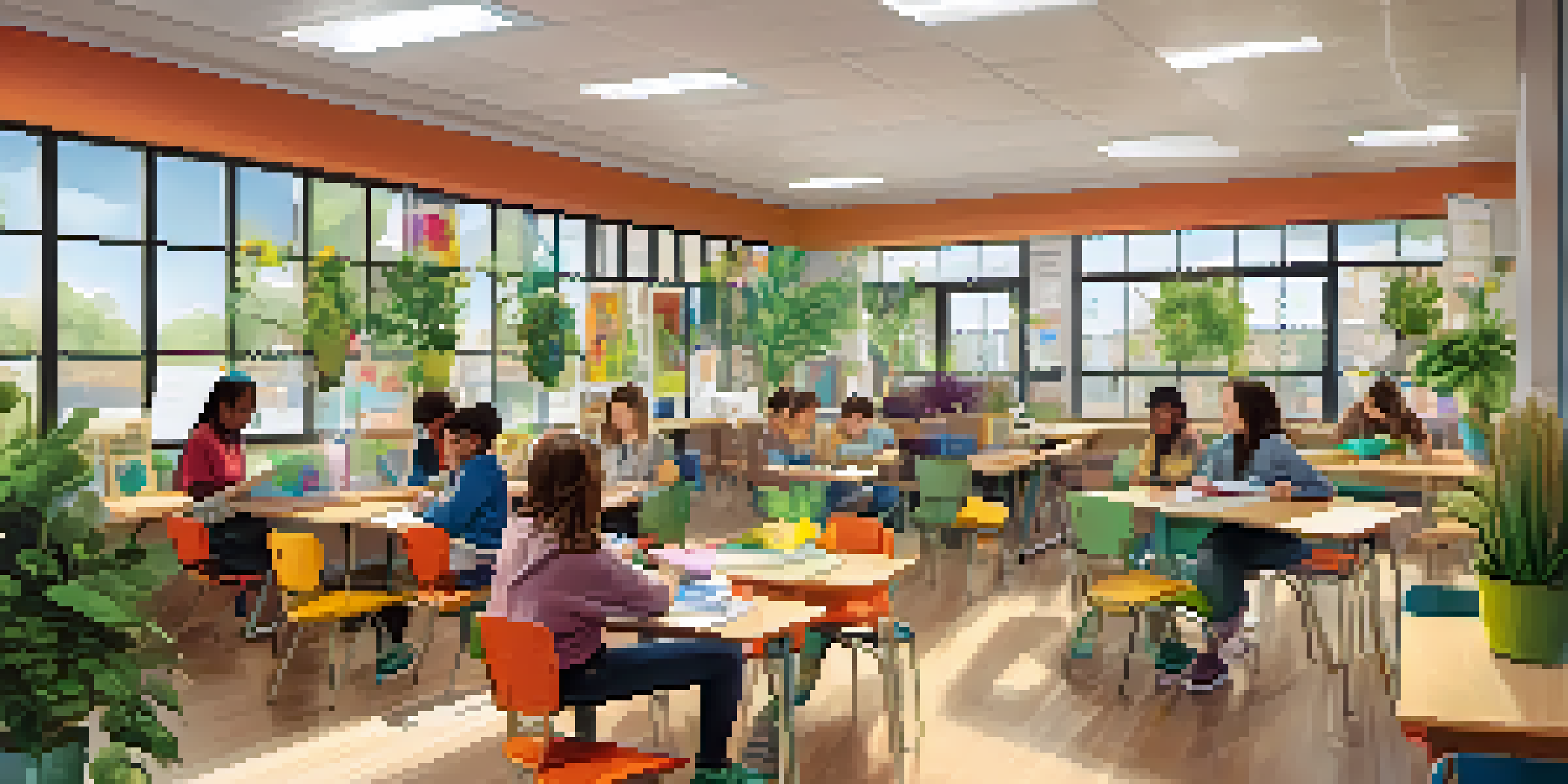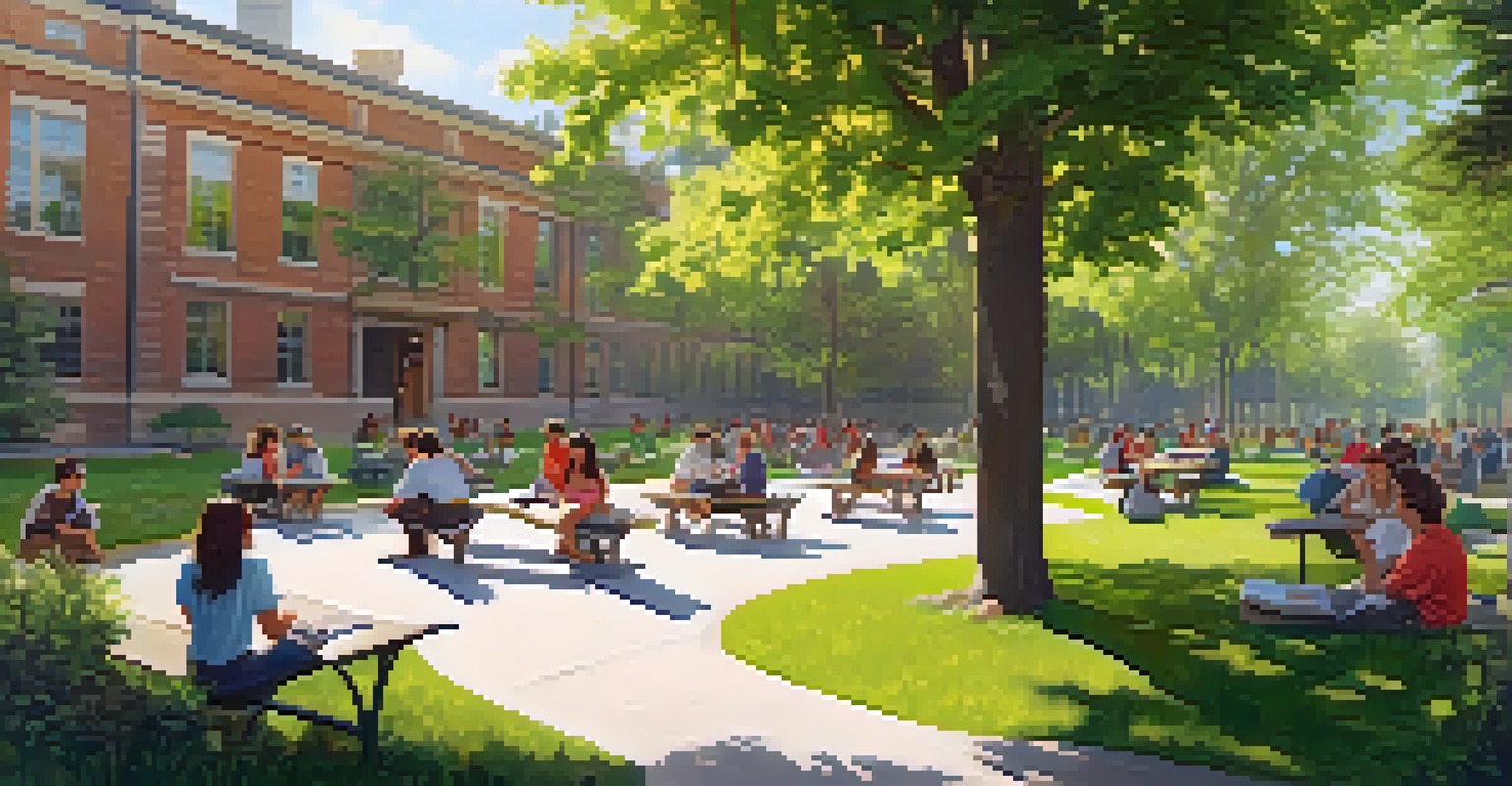Fostering Creativity in Physical Learning Environments

Understanding the Role of Environment in Learning
The physical environment plays a crucial role in how students engage with learning. Bright colors, natural light, and open spaces can stimulate creativity and encourage exploration. Think of a classroom as a canvas; the more inviting and dynamic it is, the more likely students are to express themselves.
The best way to predict the future is to create it.
When students feel comfortable in their surroundings, they're more inclined to take risks and share their ideas. For example, a classroom with flexible seating arrangements allows for collaboration and discussion, making it easier for learners to bounce ideas off one another. This interaction can spark creativity in ways a traditional setup might not.
Moreover, incorporating elements like art stations or sensory corners can cater to various learning styles. These additions not only enhance the aesthetic appeal but also serve as tools for creative expression, enabling students to engage with material in a hands-on way.
Designing Flexible Learning Spaces
Flexibility in learning environments can significantly impact creativity. When furniture can be rearranged and spaces can be transformed, students feel empowered to create their ideal learning conditions. This adaptability mirrors the unpredictable nature of creative processes, where spontaneity thrives.

For instance, a classroom that can transition from a lecture space to a group project area fosters collaboration. Students can easily shift gears, allowing them to brainstorm and develop ideas freely. This fluidity not only enhances creativity but also prepares them for real-world situations where adaptability is key.
Environment Boosts Learning Engagement
A well-designed physical space with elements like natural light and flexible seating encourages creativity and collaboration among students.
Additionally, incorporating technology into these flexible spaces can further elevate creativity. Tools like interactive whiteboards or tablets provide students with various means to express their thoughts, from digital art to presentations. Such resources can inspire innovative thinking and collaboration.
Incorporating Nature into Learning Spaces
Nature has a profound impact on creativity, and integrating it into learning environments can yield remarkable results. Studies have shown that natural elements can reduce stress and increase focus, which is essential for creative thinking. Imagine a classroom with plants, natural light, and outdoor views; it creates a calming atmosphere conducive to exploration.
Creativity is intelligence having fun.
Creating outdoor learning areas or using biophilic designs can enhance students' connection to nature, sparking their imagination. For example, having an outdoor classroom where students can engage with their surroundings can lead to spontaneous discovery and innovative ideas. This approach encourages learners to observe and interact with the world around them.
Moreover, incorporating aspects of nature into indoor spaces—like green walls or large windows—can help maintain this connection. By cultivating an environment enriched with natural elements, educators can inspire creativity that extends beyond the classroom and into everyday life.
Encouraging Collaboration Among Students
Collaboration is a vital ingredient in fostering creativity within learning environments. When students work together, they can share diverse perspectives and ideas, which can lead to innovative solutions. Think of it as a brainstorming session where each person's input adds a unique flavor to the mix.
Creating designated collaborative spaces—like group workstations or lounges—can encourage students to engage with one another. These areas can serve as hubs for creativity, where learners can discuss projects, share feedback, and inspire each other. The energy of collaboration often leads to unexpected breakthroughs.
Collaboration Sparks Creativity
Engaging students in group projects and collaborative spaces allows diverse perspectives to flourish, leading to innovative solutions.
Additionally, incorporating group projects into the curriculum can promote teamwork and shared creativity. By working collaboratively, students not only develop their ideas but also learn valuable skills like communication and compromise, which are essential in any creative field.
Promoting Autonomy in Learning
Autonomy is a powerful motivator in fostering creativity. When students are given the freedom to explore topics of interest, they are more likely to engage deeply and think creatively. This sense of ownership can transform a passive learning experience into an active, vibrant one.
For instance, allowing students to choose their projects or research topics encourages them to invest personally in their work. This investment often leads to a more passionate and creative approach, as they are pursuing something that genuinely interests them. It’s like letting a painter choose their canvas and colors; the results can be astonishing.
Moreover, providing opportunities for self-directed learning can nurture critical thinking and problem-solving skills. When students learn to set their own goals and pursue them, they develop a sense of responsibility that enhances their creative output.
Utilizing Technology to Enhance Creativity
In today's digital age, technology plays a crucial role in enhancing creativity in learning environments. Tools like virtual reality, digital art programs, and collaborative platforms can open new avenues for expression. Just as a painter uses brushes and canvas, students can utilize technology as a canvas for their ideas.
For example, using design software allows students to create intricate projects that may have been difficult to achieve by hand. This access to advanced tools can elevate their creative capabilities and enable them to experiment in ways that inspire out-of-the-box thinking. It’s all about providing the right tools to unlock creativity.
Autonomy Fuels Student Creativity
When students have the freedom to explore their interests, they become more invested in their learning, resulting in enhanced creative expression.
Incorporating technology also encourages collaboration among students, as they can easily share their work and receive feedback. This interconnectedness can lead to a richer creative process, where ideas flow freely, and innovation thrives.
Creating a Culture of Creativity and Innovation
Fostering a culture of creativity and innovation is essential for transforming physical learning environments. This culture begins with educators who model creative thinking and encourage students to take risks. When teachers celebrate creativity, it becomes a core value within the classroom community.
Establishing routines that prioritize creative thinking—like brainstorming sessions or creative challenges—can help embed this culture. For example, dedicating time each week for students to share their creative projects fosters an atmosphere of support and inspiration. This practice reinforces the idea that creativity is not just an occasional task but a fundamental part of learning.

Additionally, highlighting and rewarding creative efforts can motivate students to embrace their innovative side. Recognizing unique ideas and approaches encourages others to think outside the box, creating a ripple effect of creativity throughout the learning environment.